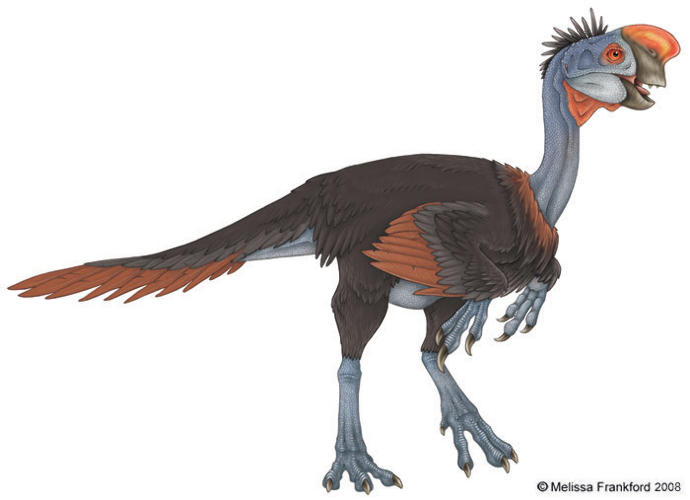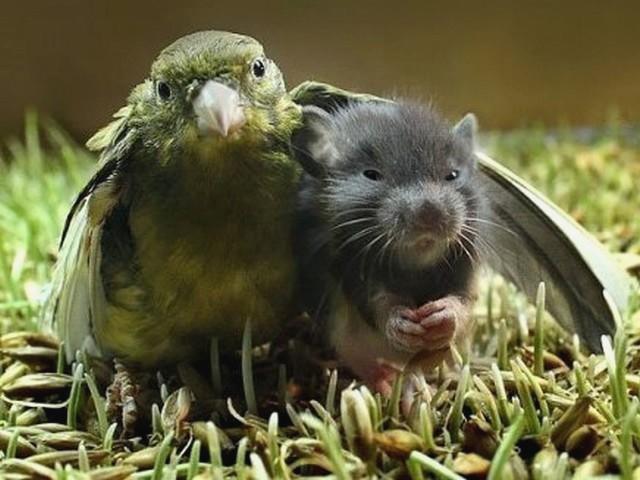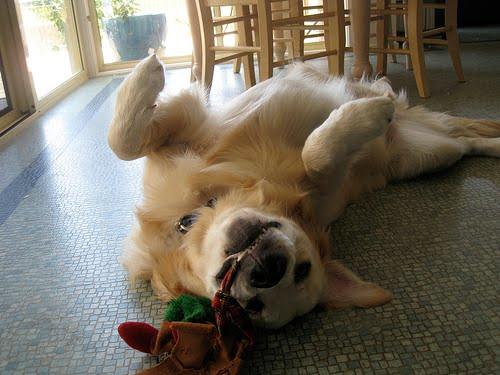
Along with the evolution of tetrapods from lobe finned fish and the evolution of man from earlier apes, one of the most famous examples of evolution at a broad scale is the evolution of birds from earlier species of dinosaurs. But one commonly asked question was how and why did they evolve wings. A commonly sighted argument from creationists is that a half of wing would be useless to a bird. Thus the wings would have had to have evolved in a single generation which would be a statistical improbablity. However there is a serious problem with this argument.

Which is that a half a wing is in fact useful. What can you do with it? You can glide with it. There are many living examples of this today such as flying squirrels and flying phallangers that use an underdeveloped wing membrane to glide between trees. However, there is little evidence of arboreal dinosaurs before wings started to evolve. So why did wings first evolve? Some have speculated that they were able to use their wings as rudders to help them cut tight corners when running or that flapping their wings helped them run up steep inclines. However recent finds have revealed a completely different explanation for the origin of the wing. But before we discuss this lets talk a little bit about taxonomy.
Often when we talk about the different kinds of terrestrial vertebrates, birds are talked about as though they are a group separate from reptiles or they "evolved from" reptiles but are now a different clade of organism. However, contrary to what creationists would lead you to believe, evolution has NOTHING to do with one organism evolving into a fundementally different "kind" of organism. Rather it is a twin nested heirarchy of speciation events giving rise to new clades within the preexisting parent clade. This principal is called Mayr's law of monophyly. So a commonly spoken phrase is that birds evolved from dinosaurs. While this is technically correct it would lead you to believe that at some point birds became a separate "kind" of animal from dinosaurs. However (in contradiction to the #1 creationist strawman argument) no organism will ever belong to a different clade than its' parent clade so it's not just that birds evovled from dinosaurs, birds ARE dinosaurs just as they're tetrapods and vertebrates. And since dinosaurs were reptiles, birds are reptiles. Simply put, in order for a clade of organisms to be monophyletic, it must include all the descendants of the common ancestor of all species within that clade. And since lizards and turtles share a common ancestor and lizards and birds share a common ancestor that didn't give rise to turtles, reptilia is paraphyletic (including some but not all descendants of the common ancestor of the clade) if it doesn't include birds.

Yet birds (on the surface) seem to very distinct from reptiles. Indeed at first glance they seem more like mammals than reptiles. So much so that taxonomists in the 18th and 19th century believed that birds were more closely related to mammals than other reptiles. Birds and mammals are warm blooded while reptiles are cold blooded. Birds and mammals have high levels of intelligence while reptiles exhibit simple, stereotyped behavior and most poigniant to this issue, reptiles exhibit a very limited degree of parental care usually being restricted to only looking after the eggs and the few who do look after thier young post hatching only care for them in infancy. Meanwhile both birds and mammals look look after their young usually to adolesence.

Being mammals, we're very familiar with the anatomical adaptations we evolved to help care for our young; mammary glands that produce milk to nourish our offspring (mammal<=>mammary). However, while some birds have glands in their crop to produce a milk like substance for their young (such as pigeon milk) such features aren't universal across all 10,000 species of birds. Meanwhile every mammal has mammary glands of some kind. The most early divergent mammals, the monotremes, do have mammary glands. However, they don't have nipples, rather they have an area of skin on their underside that secrets milk that the infants then lick up. This would imply that parental care was already present in the common ancestor of all living mammals. Likewise, the presence of some degree in parental care in virtually all birds, including in both branches of the earliest division of the Aves clade (the palognath-neognath division) implies that the common ancestor of all living birds cared for their young. But if not something to nourish their babies, what anatomical/physiological adaptation did birds evovle to help care fot their young?

While classical depictions of dinosaurs were as scaly, lizard like monstrocities, new fossils are showing that they are more bird like than we ever thought. The first evidence of feathers in dinosaurs came from the most famous transitional fossil known, Archeaopteryx lithographica. Contrary to popular belief, Archaeopteryx isn't 50% bird 50% dinosaur, it's 100% both just like humans are 100% vertebrates and 100% mammals. The first skeleton of Archeaopteryx was so well preserved that the impressions of its feathers could still be seen. This was the first clue that many dinosaurs were covered with feathers as opposed to scales.

Feather impressions have not only been found in prehistoric fossil birds but also in some of the more bird like dinosaurs such as the famous dromeosaurs such as velociraptor. (That's right JP/JW fans, the "velociraptors" looked more like big turkeys than reptilian monstrocities.) In all actuality, the depictions of Velociraptor in JP/JW was unrealistic in so many aspects, but that's another story. One of the most famous examples in the Microraptor which was found in China. However, we're now finding evidence that feathers were far more widespread in therapods than once thought. In fact, in 2012 a 126 million year old relative of T-Rex was found known as Yutyrannus was discovered with feather impressions surrounding its sekeleton. This implied that the famous Tyranosaurus rex also possesed (to some extent) feathers.

It is abundantly clear why feathers first evolved; the same reason as fur, insulation. Most of the feathers that are found on non-avian dinosaurs are long and filamentous, much like the feathers of kiwis and emus. But how did feathers evolve into components that could support flight. Well to understand this we first have to look at a dinosuar known as the Oviraptor.

When oviraptor remains were first discovered in mongolia, it was found in close proximity to a dinosaur nest. The paleontologists who discovered it had assumed that it was raiding the nest and hence gave it the name Oviraptor meaning "egg thief". And many subsequent depictions show it raiding the nests of other dinosaurs. And from many of its skeletal features, it had long been known that Oviraptor was one of the most bird like dinosaurs in existance. However a recent fossil find challenged many long held beliefs about the Oviraptor's behavior.

Recently, another fossil Oviraptor was found in proximity to a dinosaur nest. However, it was not near the nest as it would've been had it been trying to steal the eggs. Instead it was sitting on the nest, and not only sitting on the nest, but was doing so in the exact same position that a chicken uses to incubate its eggs.

Then it dawned on paleontologists; the Oviraptors weren't raiding the nests of other dinosaurs. Those eggs were Oviraptor eggs and they were incubating them. And, looking at the upper arm bones of the oviraptor, there are also tiny notches that are present in living birds today. These notches anchor the mucles that are attached to the birds flight feathers which allows them to either spread them or fold them up. Similar notches have been found in other bird like dinosaurs such as the dromeosaurs (i.e. "raptors"). Then it became apparent why flight feathers first evolved.

It had nothing to do with locomotion, the flight feathers (and by extension the wings) first evolved as an avian counterpart to the mammary glands of mammals. While mammals use their mammary glands feed their offspring (i.e. "nurse" them) birds use their wings to keep their young warm (i.e. "brood" them). And the similarities just keep coming.

Since biological evolution is at its core, the success of the traits that can be best reproduced, it only stands to reason that the species that are best at passing on their genes are the most likely to survive. One way to do that is to care for your offspring. Mammals accomplish this in part by nursing their young. However, there is more to caring for your offspring than merely feeding them. You must also be willing to protect this. In mammals, nursing not only feeds the baby, but releases dopamine which is a "feel good" hormone that has a relaxing affect for the mother as well as oxytocin. This is known as the "love hormone" and it causes mammals to develop a strong emotional bond with whoever's physical contact induced the oxytocin release. This strengthens the mother-infant bond and gives the mother a much stronger urge to care for and protect her baby. While birds don't have oxytocin, they have an analogous counterpart known as mesotocin. And just as oxytocin and endorphins are released when mamals nurse their young, mesotocin and endorphins (another feel good hormone) is released by birds when they brood their young.
https://www.ncbi.nlm.nih.gov/pubmed/21741977

And this is a prime example of how evolution can use a structure that evolved for one function and repurpose it to serve a very different one. When the bird like dinosaurs first started to exhibit extended parental care and incubate their eggs/brood their young, they probably had forearms that resembled those of most other therapod dinosaurs. But those with slightly longer feathers one their wings and slightly longer arms could better incubate/brood their young and would be selected for. Gradually, the arm and feathers would frow longer and longer until it was large enough that it could aide in aspects of locomotion. Perhaps if they outstretched them they could jump longer distances which would be more beneficial on rugged terrain. From there they could aide in gliding and ultimately leed to flight all while retaining their original functional as an auxiliary reproductive organ. And this isn't the only example, the mammary glands of mammals are actually modified sweat glands. Furthermore, the repurposing doesn't have to be strictly anatomical, the neurological frameworkl can be utilized for other functions.

Something seen quite often in birds is that they will "pat" an animal that they've bonded with with their wings. This is because in their neurological framework, the brooding postion is one of bonding and the bonding function in the brain is activated when they have an individual that they care about under their wing. Take for example penguins. Thier wings are much too small to brood their young. Rather, they've evolved a skin flap. However, they will still place their young under their wing to initiate a "bonding response. This is how displays of affection first evolved and we can see this in not only birds but mammals as well.

When a dog wants attention, they will often "roll over" or sit in a position that shows their abdominal section. They do this as a gesture of trust and this is because the teets are located on the abdominal region of the dog. When female dogs nurse their puppies they use this same position and like in all other mammals, it releases the bonding hormone. But because the neurological framework exists to view this as a postion to be in when you're bonding with an individual(s) (i.e. their puppies), they use it as a display of trust and affection to others. And something similar is seen in many social mammals.

Because the mammary glands of simian primates is positioned on the chest as opposed to the abdomen, the mother has to actually "hug" her baby to have it in a postion where it can nurse. And just as the brooding position in birds and the nursing position in dogs made a predisposed "bonding position", the postion in which simian primates hold their young to nurse them also made a prediposed bonding position. If you don't know what I'm getting at, it's the reason that we hug the way that we do; because it's the same position that a mother would hold her baby in while nursing it.

So if you've ever wondered why boobs "just happened" to be in the exact spot to be in the way when you hug someone, now you know why.
All of this would also explain why bi-parental care is so much more common in birds than in mammals (81% as opposed to 6%). Because as birds evolved the ability to fly, their was a strong selective pressure for both geneders to have fully formed auxiliary reproductive organs because their auxiliary reproductive organs (their wings) evolved a secondary function that became vital to their survival. Furthermore, as the wings became larege and larger, they subsequently got better and better at brooding their young. Had the wings not evolved the ability to get birds off the ground and had they evolved to the size that they are now with no secondary function, while they would be better at brooding their babies they would be so cumbersome that the cost would outweigh the benefits. And while having large wings may restrict the movement of birds on the ground the benefit of making them flight capabilities far outweighs any handicap their wings cause them. But since they're now that large, their wings are also much better at incubating their eggs and brooding their young and since both genders need wings to fly (and survive) it would only make sense in accordance with evolutionary economics that both genders would use their (overdeveloped) auxiliary reproductive organs to care for their offspring. Just like in mammals, larger and larger mammary glands could produce more and more milk for their babies. But eventually they would get so large that they would become cumbersome for their owner and the cost would outweigh the benefits (Busty girl problems). That is unless, they adopted a secondary function that had a benefit that outweighed whatever drawback they had. But since mammary glands haven't evolved a secondary function, there was never any selective pressure for the males to develop fully formed mammary glands.

And unfortunatley for us mammals, boobs can't get us airborne :(
What Girls & Guys Said
Opinion
3Opinion
A very informative, interesting article
Nice article! ☺️
awesome mytake
Share the first opinion in your gender
and earn 1 more Xper point!